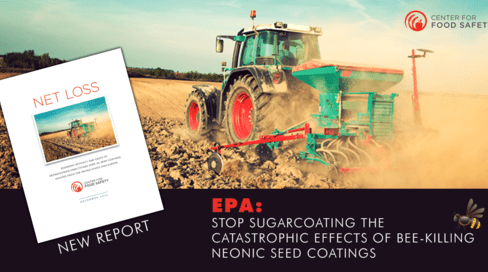Cornucopia’s Take: Center for Food Safety’s report, Net Loss, describes the EPA’s refusal to regulate neonicotinoids, despite increasing evidence that these insecticides are harmful to the environment and not beneficial to farmers. Neonics need to be removed from usage in the world’s agricultural systems. Of course they are not allowed in organics.
EPA Should Stop Sugarcoating the Catastrophic Effects of Neonic Seed Coatings
Center for Food Safety
by Larissa Walker, Pollinator Program Director
Bee-toxic seeds are planted on nearly half of all U.S. cropland. These neonicotinoid-coated crop seeds are the largest single use of insecticides in the country and they are not regulated by the Environmental Protection Agency (EPA). Would you be surprised to learn that these same insecticides often provide no benefit to farmers – that their use can actually do more harm than any potential good? It’s true, and the data is outlined in Center for Food Safety’s new report, Net Loss. But as shocking as both of these facts may be, the most upsetting reality is that the EPA has the ability to fix both of these issues, but won’t. In fact, it is their job to address these problems through proper regulation – one that they’ve been failing miserably at.
Neonicotinoids (or, “neonics”, for short) are the most widely used insecticides in the world and they are highly toxic to bees and other pollinators. While neonics can be applied as sprays, soil drenches, trunk injections, and in other forms, the primary use of these chemicals is as a seed coating for annual field crops (like corn, soybeans, and cotton), planted on at least 150 million acres across the U.S. More alarming than the vast acreage that we’re using these products on is the fact that when used as a seed coating, much of the chemical doesn’t actually enter the crop itself. Depending on the crop, only about five percent [!] of the active chemical in the seed coating enters the plant – even this small amount delivers enough of a dose to make the plant highly toxic to bees. The remaining 95 percent of the chemical is left to pollute the environment through seed dust or soil contamination and water runoff – imagine the damage that does!


